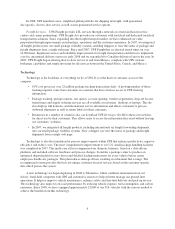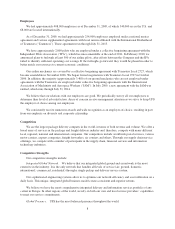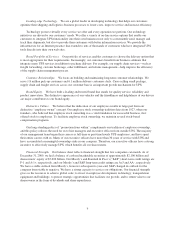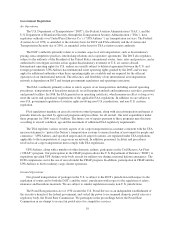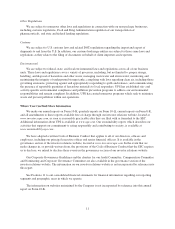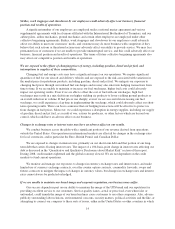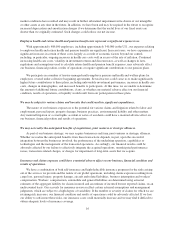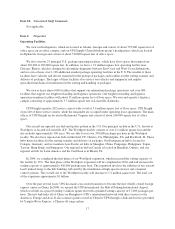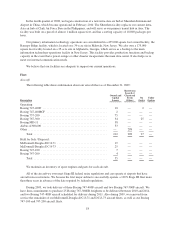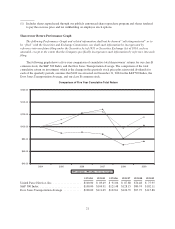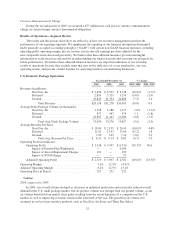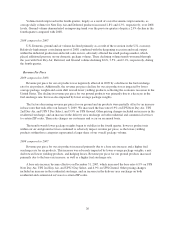UPS 2009 Annual Report Download - page 28
Download and view the complete annual report
Please find page 28 of the 2009 UPS annual report below. You can navigate through the pages in the report by either clicking on the pages listed below, or by using the keyword search tool below to find specific information within the annual report.market conditions have resulted and may result in further substantial impairment write-downs of our intangible
or other assets at any time in the future. In addition, we have been and may be required in the future to recognize
increased depreciation and amortization charges if we determine that the useful lives of our fixed assets are
shorter than we originally estimated. Such changes could reduce our net income.
Employee health and retiree health and pension benefit costs represent a significant expense to us.
With approximately 408,000 employees, including approximately 340,000 in the U.S., our expenses relating
to employee health and retiree health and pension benefits are significant. In recent years, we have experienced
significant increases in certain of these costs, largely as a result of economic factors beyond our control,
including, in particular, ongoing increases in health care costs well in excess of the rate of inflation. Continued
increasing health-care costs, volatility in investment returns and discount rates, as well as changes in laws,
regulations and assumptions used to calculate retiree health and pension benefit expenses, may adversely affect
our business, financial position, results of operations or require significant contributions to our pension plans.
We participate in a number of trustee-managed multi-employer pension and health and welfare plans for
employees covered under collective bargaining agreements. Several factors could cause us to make significantly
higher future contributions to these plans, including unfavorable investment performance, increases in health care
costs, changes in demographics, and increased benefits to participants. At this time, we are unable to determine
the amount of additional future contributions, if any, or whether any material adverse effect on our financial
condition, results of operations, or liquidity would result from our participation in these plans.
We may be subject to various claims and lawsuits that could result in significant expenditures.
The nature of our business exposes us to the potential for various claims and litigation related to labor and
employment, personal injury, property damage, business practices, environmental liability and other matters.
Any material litigation or a catastrophic accident or series of accidents could have a material adverse effect on
our business, financial position and results of operations.
We may not realize the anticipated benefits of acquisitions, joint ventures or strategic alliances.
As part of our business strategy, we may acquire businesses and form joint ventures or strategic alliances.
Whether we realize the anticipated benefits from these transactions depends, in part, upon the successful
integration between the businesses involved, the performance of the underlying operation, capabilities or
technologies and the management of the transacted operations. Accordingly, our financial results could be
adversely affected by our failure to effectively integrate the acquired operations, unanticipated performance
issues, transaction-related charges, or charges for impairment of long-term assets that we acquire.
Insurance and claims expenses could have a material adverse effect on our business, financial condition and
results of operations.
We have a combination of both self-insurance and high-deductible insurance programs for the risks arising
out of the services we provide and the nature of our global operations, including claims exposure resulting from
cargo loss, personal injury, property damage, aircraft and related liabilities, business interruption and workers’
compensation. Workers’ compensation, automobile and general liabilities are determined using actuarial
estimates of the aggregate liability for claims incurred and an estimate of incurred but not reported claims, on an
undiscounted basis. Our accruals for insurance reserves reflect certain actuarial assumptions and management
judgments, which are subject to a high degree of variability. If the number or severity of claims for which we are
retaining risk increases, our financial condition and results of operations could be adversely affected. If we lose
our ability to self-insure these risks, our insurance costs could materially increase and we may find it difficult to
obtain adequate levels of insurance coverage.
16


